EVENTS CONVENT HIGH SCHOOL
25/01/2022 CLASS- 3 SESSION 2021-22
SUBJECT :COMPUTER
CHAPTER-8
MICROSOFT WORD
______________________________________
 |
We can check grammar and spelling mistakes and correct it.
EVENTS CONVENT HIGH SCHOOL
 |
EVENTS CONVENT HIGH SCHOOL
Question 1.Who are nomads ?
Answer: Nomads are the people who move from one place to another in search of food and fodder.
Question 2.Name any two nomad communities of India.
Answer:
Question 3.Mention the states to which the following communities belong:
(a) Gujjar Bakarwals (b) Gaddi
Answer:
(a) Jammu and Kashmir.
(b) Himachal Pradesh.
Question 4.Name any two pastoral communities of South India.
Answer:
Question 5.Who were the Dhangara ?
Answer:
The Dhangars were an important pastoral community of Maharashtra. Most of them
were shepherds, some were blanket weavers, and still others, were buffalo herders.
Question 6.How is movement of Dhangar different than that of Gujjars?
Answer:
Dhangar’s movement is guided by the annual cycle of monsoon whereas Gujjar’s movement depends upon change of season i.e winter and summer.
Question 7.Name any two pastoralist communities of Andhra Pradesh.
Answer:
Question 8.Name the act through whichuncultivated lands were taken over and given to select individuals.
Answer:
Waste Land Rules
Question 9.Name any two pastoral communities of the Himalayas which followed an annual pattern of cyclical movement.
Answer:
Question 1.Explain the movement of the Gujjar Bakarwals of Jammu and Kashmir.
Answer:The Gujjar Bakarwals migrated to Jammu and Kashmir in the 19th century in search of pastures for their animals.
Winter : When the high mountains were covered with snow and there was lack of pastures at the high altitude, they moved to low hills of the Shiwalik. The dry scrub forests here provided pastures for their herds. By the end of April, they began their northern march for their summer grazing grounds.
Summer : With the onset of summer, the snow melted and the mountain sides became lush green. By the end of September, the Bakarwals started their backward journey.
Question 2.“Under the colonial rule, the life of pastoralists changed dramatically.” Mention any four factors responsible for this change.
Answer:
Question 3.Why the Colonial government introduced the Waste Land Rules ? Explain the impact of Waste Land Rules on the pastoral communities.
Answer:
(a) Waste land Rules : Under this, uncultivated land was brought under cultivation.
EVENTS CONVENT HIGH SCHOOL
Question 1.Find the value of
(i) 26
(ii) 93
(iii) 112
(iv) 54
Solution:
(i) 26 = 2 × 2 × 2 × 2 × 2 × 2 = 64
(ii) 93 = 9 × 9 × 9 = 729
(iii) 112 = 11 × 11 = 121
(iv) 54 = 5 × 5 × 5 × 5 = 625
Question 2.Exress the following in exponential form:
(i) 6 × 6 × 6 × 6
(ii) t × t
(iii) b × b × b × b
(iv) 5 × 5 × 7 × 7 × 7
(v) 2 × 2 × a × a
(vi) a × a × a × c × c × c× c × d
Solution:
(i) 6 × 6 × 6 × 6 = 63
(ii) t × t = t2
(iii) b × b × b × b = b4
(iv) 5 × 5× 7 × 7 × 7 = 52 × 73 = 52 · 73
(v) 2 × 2 × a × a = 22 × a2 = 22 · a2
(vi) a × a ×a × c × c × c × c × d = a3 × c4 × d = a3 · c4 · d
Question 3.Express each of the following numbers using exponential notation:
(i) 512
(ii) 343
(iii) 729
(iv) 3125
Solution: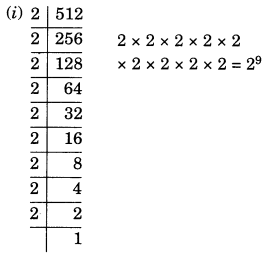
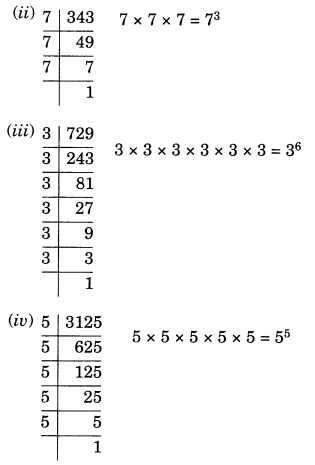
Question 4.Identify the greater number, wherever possible, in each of the following?
(i) 43 or 34
(ii) 53 or 35
(iii) 28 or 82
(iv) 1002 or 2100
(v) 210 or 102
Solution:
(i) 43 or 34
43 = 4 × 4 × 4 = 64,
34 = 3 × 3 × 3 × 3 = 81
Since 81 > 64
∴ 34 is greater than 43.
(ii) 53 or 35
53 = 5 × 5 × 5 = 125
35 = 3 × 3 × 3 × 3 × 3 = 243
Since 243 > 125
∴ 35 is greater than 53.
(iii) 28 or 82
28 =2 × 2 × 2 × 2 × 2 × 2 × 2 × 2 = 256
82 = 8 × 8 = 64
Since 256 > 64
∴ 28 is greater than 28.
(iv) 1002 or 2100
1002 = 100 × 100 = 10000
2100 = 2 × 2 × 2 × … 100 times
Here 2 × 2 × 2 ×2 × 2 × 2 × 2 ×2 × 2 × 2 × 2 × 2 × 2 × 2 = 214 = 16384
Since 16384 > 10,000
∴ 2100 is greater than 1002.
(v) 210 or 102
210 = 2 × 2 × 2 × 2 × 2 × 2 × 2 × 2 × 2 × 2 = 1024
102 = 10 × 10 = 100
Since 1024 > 100
∴ 210 is greater than 102.
Question 5.Express each of the following as the product of powers of their prime
(i) 648
(ii) 405
(iii) 540
(iv) 3600
Solution: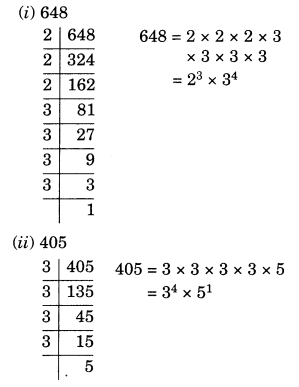
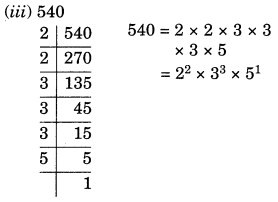
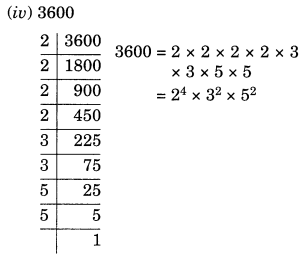
Question 6.Simplify:
(i) 2 × 103
(ii) 72 × 22
(iii) 23 × 5
(iv) 3 × 44
(v) 0 × 102
Solution:
(i) 2 × 103 = 2 × 10 × 10 × 10 = = 2000
(ii) 72 × 22 = = 7 × 7 × 2 × 2 = 196
(iii) 23 × 5 = 2 × 2 × 2 × 5 = 40
(iv) 3 × 44 = 3 × 4 × 4 × 4 × 4 = 768
(v) 0 × 102 = 0 × 10 × 10 = = 0